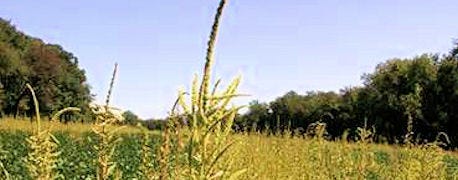September 24, 2013

Late last week, Penn State Extension Weed Specialist sent out this "yellow flag" email to agronomists: "We've tentatively identified an isolated infestation of Palmer amaranth in Southeast Pennsylvania.
"With soybean and corn grain harvest [underway], please play attention to pigweeds that survived herbicide programs in Roundup Ready crops, particularly soybeans. We're still investigating this most recent occurrence," he adds. "But we strongly suspect that seeds were spread via contaminated manure and/or hay."
What it looks like

PIGWEED ON STEROIDS? This photo of the suspected Palmer amaranth was taken in a Southeast Pennsylvania field last week.
This summer annual broadleaf weed closely resembles other pigweeds – waterhemp, smooth and redroot pigweeds. But it grows much faster and is more competitive than other pigweed species.
The mature plant amaranth is quite distinctive at this stage with long (10 to 20 inches) cylindrical seed heads rising above the soybean crop. If seeds are harvested along with grain, this weed can quickly spread into neighboring fields or farms.
Growth rates approach 3 inches per day, and often reaches 6 to 8 feet tall with yield losses of as much as 78% reported for soybeans and 91% for corn. That's why you'll want to get on top of it immediately while it's a small problem.
Grabbing the top spike (inflorescence) of a mature female Palmer amaranth plant with your bare hand is not recommended. The bracts are very stiff and sharp.
What now?
If Palmer amaranth plants aren't identified until after brown-to-black colored seeds are present, Ohio State University weed specialists advise leaving them undisturbed to avoid inadvertently spreading seed. Mark or flag areas where the plants produced seed. If you haven't already harvested the field, avoid mechanically harvesting mature plants.
Instead, physically remove the plants before harvest or leave them there, to be handled after harvest. Then carefully place them in a sturdy garden bag and remove them from the field. Burn the bags in a burn barrel as soon as possible.
Fields where Palmer amaranth seeds were produced should not be tilled during
fall or the following spring. Leaving them near the soil surface increases the opportunities for seed predation by various granivores.
If you''ve found this week in your fields, it's time to bone up on control. Herbicides that control waterhemp also control Palmer amaranth.
Check out this 11-minute youtube video produced by Ohio State University. It'll help explain the concern about Palmer amaranth and offer management options.
We will provide more information about this problem as it becomes available. Also check out www.weeds.psu.edu for more updates.
You May Also Like




